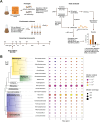Inferring replication states of bacteria and viruses in enrichment cultures via long-read sequencing
- PMID: 40182062
- PMCID: PMC11964896
- DOI: 10.1093/ismeco/ycaf041
Inferring replication states of bacteria and viruses in enrichment cultures via long-read sequencing
Abstract
Most microorganisms cannot be cultured in isolation, necessitating sophisticated methods for studying their (eco)physiology. While numerous approaches can probe the activity of given microbes in enrichment cultures, no single technique can render simultaneous data on both metabolic capacities and mobile genetic elements. Here, we apply long-read sequencing to monitor the incorporation of non-canonical bases in genome-resolved metagenomic datasets and elucidate the replication patterns of both bacteria and phages. This technology enables the simultaneous reconstruction of both prokaryotic and viral genomes (alongside genomics downstream analyses like metabolic predictions), in addition to providing information regarding their replication in enrichment cultures. By spiking the base analog 5-bromo-2'-deoxyuridine (BrdU) into activated sludge microcosms, we determined that 114 of the 118 high-quality genomes recovered were actively replicating in enrichment cultures from activated sludge and identified both slow (low BrdU incorporation and change in abundance) and rapidly replicating organisms (high BrdU incorporation and change in abundance). Some of the genomes detected exhibited regions rich in BrdU that were predicted to represent prophages in their lytic cycle. Ultimately, this novel means of monitoring the replication responses of microbes, and deciphering their genomes and active mobile genetic elements will advance and empower strategies aimed at isolating previously uncultivated microbes in pure culture.
Keywords: 5-bromo-2′-deoxyuridine (BrdU); enrichment cultures; genome-resolved metagenomics; nanopore sequencing; prokaryotic replication; prophage induction.
© The Author(s) 2025. Published by Oxford University Press on behalf of the International Society for Microbial Ecology.
Conflict of interest statement
There are no conflicts of interest to declare.
Figures


References
LinkOut - more resources
Full Text Sources

